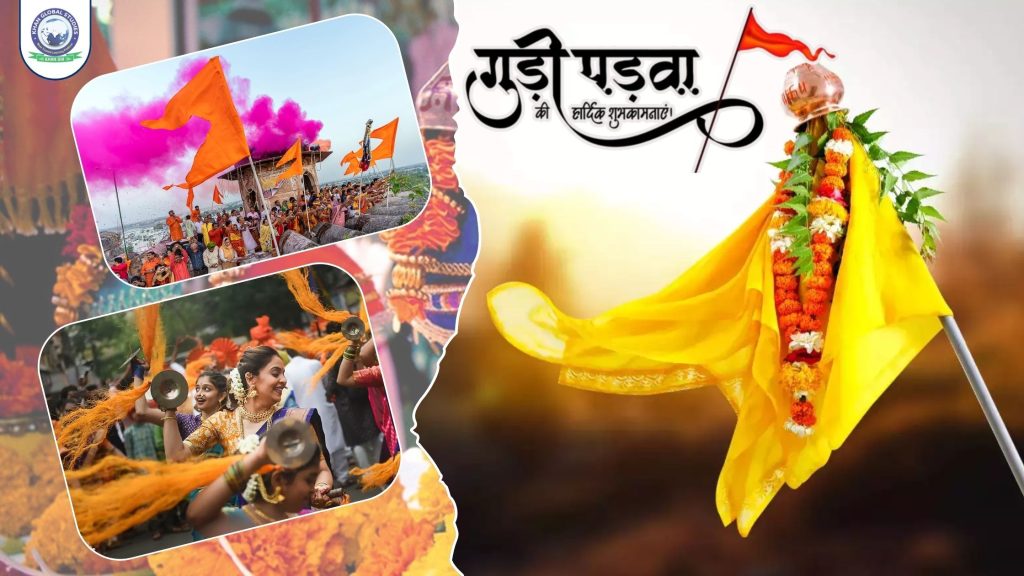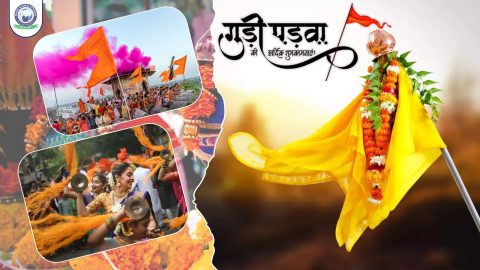Gudi Padwa is a spring festival that marks the beginning of the lunar-solar new year for Marathi and Konkani Hindus. It is primarily celebrated on the first day of the Chaitra month in Maharashtra, Goa, and Daman. The festival is known for its vibrant rangoli designs, the special Gudi flag (Gudi Dhwaja), traditional attire, festive delicacies, and grand celebrations.
A Gudi is created by decorating a long bamboo stick with a sari or dhoti, adorned with mango and neem leaves, garlands of flowers, and a string of sugar crystals (gathi). A copper or silver pot is placed upside down on top of the Gudi, symbolizing victory and prosperity.
Meaning and Etymology of Gudi Padwa
The word Gudi means “flag” and is believed to have South Indian origins.
The term Padwa is derived from the Sanskrit word “Pratipada,” which refers to the first day of every lunar month. This day is also associated with Balipratipada.
Religious and Historical Significance of Gudi Padwa
Gudi Padwa is linked with the arrival of spring and the harvesting of rabi crops. According to Hindu beliefs, on this day, Lord Brahma created the universe and time. The festival also commemorates Lord Rama’s victory over Lanka.
Additionally, this day marks the beginning of the Shalivahana Shaka era, established by Emperor Shalivahana after his victory over the Huns. In rural Maharashtra, the festival is also associated with Lord Shiva’s Tandava dance and communal worship.
Significance and Preparation of Gudi
On Gudi Padwa, every household erects a Gudi at their entrance. It consists of a bright silk cloth tied to a long bamboo stick, accompanied by neem and mango leaves, flower garlands, and a silver, bronze, or copper pot placed on top.
The reasons for erecting the Gudi include:
- Symbolizing Emperor Shalivahana’s victory over the Huns and his triumphant entry into Paithan.
- Representing the “Brahmadhwaj” mentioned in the Brahma Purana.
- Being regarded as “Indra Dhwaj,” a symbol of prosperity and good fortune.
- Believed to ward off negative energies and bring happiness and prosperity to the home.
Celebrations and Traditional Dishes of Gudi Padwa
Families prepare special delicacies, including a mixture of neem leaves and jaggery, often combined with tamarind, coriander, and other spices. This mixture symbolizes the bittersweet experiences of life and is considered beneficial for health.
Homes are decorated with rangoli, traditional attire is worn, processions are organized, and cultural events featuring music and dance take place. It is also considered auspicious to buy new items on this day.
Significance of Gudi Padwa in Other Indian States
In Maharashtra, this festival is known as Gudi Padwa, whereas Konkani Hindus celebrate it as Sausar Padvo or Sausar Padyo. Kannada Hindus in Karnataka observe it as Yugadi (Ugadi), while Telugu Hindus in Andhra Pradesh and Telangana also celebrate it as Ugadi. Among the Sindhi community, this day is observed as Cheti Chand, marking the appearance of Jhulelal Dev. On this occasion, special dishes like tahri (sweet rice) and Sai Bhaji are prepared.
However, not all Hindus celebrate this as their New Year. In Gujarat, the New Year is observed during Diwali, whereas in North India, Punjab, and Bengal, the New Year falls on Vaisakhi (April 13-15). This festival is also widely celebrated among Hindus and Buddhist communities in South-East Asia.
Conclusion
Gudi Padwa not only marks the beginning of the New Year but also holds historical, religious, and cultural significance. This festival teaches us the values of new beginnings, positivity, and prosperity in life.




